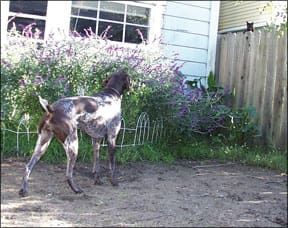Dogs are a predatory species. While cats think of themselves as predators, dogs often think of cats as prey. Still, many canines and felines live together in happy harmony. If yours don’t, here are some things to do when Fido chases Felix.
1:Separate dog and cat when you’re not there to supervise. You need to protect your cat from injury or possible death, and you want to prevent your dog from practicing the unwanted chasing behavior. Depending on the intensity of the chasing behavior, you may want your cat behind a solid door when you’re away to ensure protection, or baby gates may be enough to give kitty safe zones to use as she chooses. When you are there to supervise, you still need to manage your dog so he doesn’t get reinforced for chasing the cat. Having something run away when you chase it is highly reinforcing to a dog with strong predatory behaviors.

288
2:Counter-condition and desensitize. You can reprogram your dog’s automatic response to chase a small moving creature. Have your dog on a leash when your cat enters the room. The instant your dog notices the cat, start feeding him bits of very high-value treat, such as boiled chicken. As long as the cat is in sight and moving, keep feeding. If kitty leaves the room or jumps up on a high piece of furniture you can stop feeding the bits of chicken to your dog – but keep him leashed!
Eventually your dog’s response to arrival of the cat will be to swivel his head to you with a happy “Where’s my chicken?” look. At some point, it’ll work even off-leash. Note: You may also need to counter-condition your cat to be happier and calmer about the presence of your dog! (For more on counter-conditioning your dog to cats, see “Cats and Dogs Living Together,” WDJ June 2007.)
3:Use a happy recall. If you yell at your dog when he takes off after the cat, the stress and intensity in your voice is likely to increase the intensity of his chasing behavior. If you’ve taught him a solid recall and done some counter-conditioning, your happy recall voice is more likely to succeed in calling him off the chase. If the recall isn’t happening for you, teach an emergency “pause” cue such as “Stop!” or “Wait!” If you teach this as a fun game, with your cue meaning, “Hey, I’ve got chicken!” you can pause your dog long enough for the cat to escape through the baby gate to a safe room.
4:Keep your cat indoors. Indoor living is safer for your cat all the way around, and especially if your dog likes to chase her. Many dogs who live peaceably with their indoor cat friends will still chase moving felines outside. I’m sure mine would. After all, it’s expecting a lot to ask a dog to distinguish between a high-speed squirrel, bunny, or cat. If your cat insists on outdoor exposure, build her a screened-in enclosure, or attach the “Cat Fence-In” containment system (catfencein.com or 888-738-9099) to your fence and let her out in the yard only when your dog is securely contained indoors.
5:Consider rehoming one of them. This is, obviously, a very last resort. Some dogs will never be trustworthy with cats. If you think your dog is really intent on killing your cat and the counter-conditioning doesn’t change his mind, you have two options. Strict management so the two of them never meet (and management always has the risk of failure), or rehoming one of them so they both can live happily ever after in separate homes.






Seems like at this point one of my dogs will be getting rehomed. I have an aussie and he is intent on chasing my cats, inside AND outside. today one of our cats got out our back door and into our fenced back yard and the dog got ahold of her. No injuries to the dog or the cat since i was able to intervene within about 60 seconds of hearing him start barking and i was able to separate them easily but at this point rehoming one dog vs rehoming 8 cats all in varying ages (2 to 13years old) is the easier choice. Such a shame though since he has been a GREAT dog when it comes to interacting with my young kids and my other 3 dogs. The research on trying to tame the prey drive for an outdoor dog has just not been there. This dog has never been allowed in the house due to the cats but now that weather is nice occasionally a cat sneaks out without getting noticed…and I need to be able to trust that my dogs will ignore them. My other 3 that I have, know the cats are off limits but our aussie, in the year we have had him.. just never has gotten it through his head and I don’t need it to spill over to the other dogs…or worse have him injure or kill a cat..
Thanks for your tips!
One method is to use a protective carrier for the cat while the puppy is under leash control. I agree with the tips of 1,2 and 3 no. Really helpful tips.